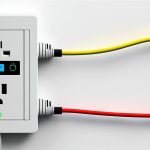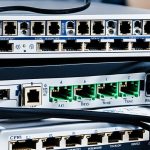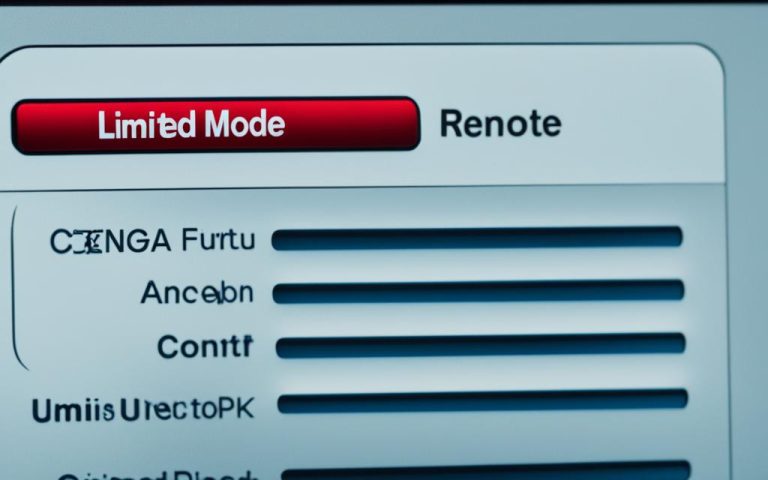A network drop is a key part of a network that lets devices connect to the internet and share data. It’s vital for communication and sharing files. Without it, accessing the internet and network services would be tough.
Network drops are crucial for staying connected in today’s tech world. They make sure devices can join the internet and use network services smoothly.
- Packet loss can cause network slowdowns and slow down internet use1.
- Video calls and audio programs are hit hard by packet loss1
- Packet loss rate is shown as a percentage, comparing lost packets to total sent1.
- Causes include network jams, weak signals, interference, and security issues12.
- Packet loss leads to poor communication, slower speeds, and security risks1.
- Network jams are a big reason for packet loss, like traffic jams on roads2.
- Wireless networks often face packet loss due to signal strength and interference2.
Key Takeaways:
- A network drop is a connection point that enables devices to access network resources.
- Packet loss can disrupt network connectivity and impact specific applications like video calling and audio programs the most.
- Packet loss rates are expressed as percentages and can vary based on the causes, such as network congestion and interference.
- Addressing packet loss involves diagnosing the root causes and implementing solutions like increasing bandwidth or reducing obstructions.
- Monitoring network performance and implementing preventive measures can help mitigate packet loss in the long term.
What is Packet Loss and its Causes?
Packet loss happens when some data packets don’t make it to their destination. This can really slow down a network, causing connectivity problems. The number of lost packets shows how big the issue is3. For instance, if none of 4 packets arrived, that means all 4 were lost, which is 100% packet loss4.
Several things can cause packets to get lost. Network congestion is one, happening when too much data tries to go through at once. When this happens, some packets get dropped to manage the load5. Old network gear and software bugs can also lead to packet loss5. Plus, security threats like DDoS attacks can increase packet loss too3.
It’s important to spot packet loss to fix network issues. Tools like the ping command show how many packets were sent, received, and lost. The “tracert” command helps find out where packets are getting dropped, making it easier to fix problems4. By tracking packet loss over time, network teams can find patterns and take steps to improve things4.
Effects of Packet Loss
Packet loss can affect network performance in many ways. It can make communication quality poor, causing delays and gaps in real-time apps like VoIP6. It also reduces data speed and makes communication less secure, giving hackers a chance to break in. This risks the safety and privacy of the data being sent6.
When packets get lost, the network can’t send information fully or on time. This makes communication slow and unreliable. For apps that need high-quality communication, like video calls or sharing files in real-time, packet loss can really hurt the experience7.
Packet loss also means less data gets through7. This slows down how fast data moves and can cause delays and breaks in sending data. Networks start to perform poorly when more than 5% of packets are lost7.
Loss of packets can also make networks slower to respond7. Latency is how long it takes for data to get from one place to another. When packets are lost, it takes longer for data to arrive, causing delays and problems in real-time activities7.
Poor network quality from packet loss can have big effects. High packet loss can make voice calls sound bad or videos pixelated and buffering a lot. This hurts how users feel, makes work harder, and can harm a business’s image7. Losing data can also cost a lot of money. Gartner says the average cost of IT downtime is $5,600 per minute8. Packet loss can cost between $140,000 to $540,000 an hour8.
To fix packet loss issues, using tools to monitor and troubleshoot is key. Tools like Opsview help find and fix packet loss problems early. They help IT teams spot and solve network issues, like congestion or ISP problems6. Tools like ping and mtr also help measure packet loss, giving insights into network health6.
In summary, packet loss has big effects on how networks work, how well communication is, and how secure it is. It can slow down data, make it take longer to get there, and make communication less safe. It’s important for companies to use tools and take steps to prevent packet loss. This helps keep networks running well and users happy678.
Detecting and Fixing Packet Loss
It’s key to spot and fix packet loss to keep your network running smoothly. When data packets don’t make it to their destination, you might face slow speeds, poor quality audio and video, trouble accessing websites, and longer wait times9.
A ping test is a way to check for packet loss. It sends packets to a spot and looks for ones that don’t come back. This shows how much data is lost, helping you see the problem9. Doing ping tests often can help find network issues early.
To solve packet loss, you can try a few things. Boosting your network speed helps by easing congestion and cutting down on lost packets. You might need to upgrade your network setup or use traffic management tools8.
Deep packet inspection (DPI) is also useful for finding and fixing packet loss. It looks at network traffic closely to make sure important packets get through. This helps lower the chance of losing data8.
Keeping your network gear and software updated is crucial. Old or faulty hardware can cause packet loss98. Updating your equipment and software can make your network faster and more reliable, reducing packet loss8.
Using wired connections is better for a stable network. Wi-Fi is more likely to lose packets because of interference and weak signals8. Wired connections cut down on packet loss and keep data flowing smoothly8.
To fix packet loss, check your network setup, make sure devices are properly connected, and fix any hardware, software, or security problems9. By doing these things and taking steps to prevent issues, network managers can lessen packet loss and keep networks running well.
| Causes of Packet Loss | Effects of Packet Loss |
|---|---|
|
Preventing Packet Loss
To keep networks running smoothly, it’s key to prevent packet loss. By using smart strategies and managing network software well, companies can lessen packet loss’s effects. This keeps networks working at their best.
Monitor Network Performance
Watching how the network performs is vital to stop packet loss. Tools for monitoring networks give real-time updates on their health. By looking at metrics like latency and packet loss rates, companies can spot and fix problems early.
Packet loss tests help see how much loss is happening and where to improve. These tests send data packets and count how many get lost. This info helps network teams find and fix packet loss causes.
Manage Network Software
Good management of network software is key to avoiding packet loss. Keeping firewalls, routers, and switches updated helps them work better and reduces packet loss risk.
Old software can lead to packet loss and network troubles. Updating software fixes bugs and speeds up data transfer, cutting down packet loss chances.
Using Quality of Service (QoS) settings also helps. QoS makes sure apps like VoIP calls or video streaming work well, even with packet loss. It makes sure the network uses its resources well for a smooth experience.
Take Preventive Measures
Stopping all packet loss isn’t always possible, but there are steps to lessen it. These steps include:
- Restarting network systems and devices often to fix problems.
- Checking network connections and cables for any issues.
- Using cables instead of Wi-Fi when possible, as Wi-Fi can lose packets more.
- Keeping software up to date to fix issues and stay compatible.
- Replacing old or broken hardware like routers or switches that cause loss.
These steps help stop packet loss and keep networks stable and reliable. It’s also smart to use network experts to make sure these steps are done right.
Stopping packet loss helps avoid the costs of network downtime and keeps networks running well. By watching the network, managing software, and taking steps to prevent loss, packet loss rates go down. This makes for a smoother network experience.
Fortinet’s Cyber Glossary has lots of info on packet loss and its effects. Intel also has tips for gamers on fixing packet loss for better network stability.
Stopping packet loss is crucial for a dependable and efficient network. With network monitoring, software management, and preventive steps, companies can keep their networks running smoothly and avoid disruptions.
Understanding Network Software
Network software is key to managing and improving network operations. It gives organizations the tools to keep data flowing smoothly, improve communication, and boost network security.
Network software includes apps and tools that help manage, design, and set up networks. It acts as a central hub for admins to manage tasks, check performance, and make sure users have a good experience.
User management is a big part of network software. It lets admins control who can access the network, add or take away users, and set their roles and permissions. This keeps data safe and makes work flow better, making the network more productive.
File management is another important part. With this, admins can keep track of where data is, set up who can see it, and make sharing and working together easy. This way, data is safer if hardware fails and stays true across the network.
Network security systems are vital in today’s connected world. They protect sensitive info and stop unauthorized access. Top-notch security software uses things like behavioral analytics and AI to fight off complex cyber threats, keeping networks and data safe. Even though security costs a lot, it’s a must, especially for schools with personal data.
SDN has changed how we manage networks by separating software from hardware. This makes managing infrastructure easier and helps networks adapt to new tech. Before, control and infrastructure layers were together. SDN split them, giving admins more control over managing, monitoring, automating, and fixing networks10. There are many kinds of network software, like for storing data, archiving, and patching10. These meet different needs for managing data, storage, and security, making networks run smoothly and work better.
Key Components of Network Software
Network software is crucial for communication and data transfer across computer networks. It has three main parts: the application layer, control layer, and infrastructure layer.
The application layer is where different applications and services live. It lets users get to and use network resources.
The control layer is the network’s brain. It takes orders from applications and makes sure network parts work right. This layer keeps traffic moving smoothly, makes sure data flows well, and boosts network speed.
The infrastructure layer includes the physical devices that move data around. These are things like routers, switches, hubs, and more.
APIs (Application Programming Interfaces) help these parts talk to each other. They make sure everything works together well. APIs send info from the application layer to the control and infrastructure layers. This helps data move fast and networks run well.
When these parts work together, network software makes computer networks run smoothly. It supports many applications and services11.
Types of Network Software
Networks use different software types for smooth running and good communication. It’s key for businesses and groups to know these software types. They include network storage, data archiving, and patch management software.
Network Storage Software
Network storage software is crucial for managing data in a network. It lets data be stored in one place, making it easy for users to get to it. This software helps in storing and getting data back, making data handling better and safer.
It also has access controls to keep sensitive info safe. Plus, it helps in backing up and recovering data, keeping it safe from loss and reducing downtime.
Data Archiving Software
Data archiving software is key for keeping lots of data safe and in line with laws. It helps in storing and finding old data, keeping it safe and making it easy to get back when needed. This software uses methods like compression to save space and cut costs.
Archiving data frees up space, boosts system speed, and keeps data safe for a long time.
Patch Management Software
Patch management software makes updating network devices easy, keeping them safe and current. It tackles security risks and fixes bugs, lowering the chance of cyber attacks. This software makes updating a breeze by managing updates in one place.
It keeps networks up to date with security patches and updates, cutting down on cyber threats and making networks more reliable.
Using network storage, data archiving, and patch management software helps improve networks. It makes data handling better and keeps networks safe and reliable.
For more info on network software, check out these resources:
- Software Defined Networking
- Common Network Problems
- 7 Common Network Issues and How to Resolve Them
Local Area Networks (LANs) and Wide Area Networks (WANs)
In networking, Local Area Networks (LANs) and Wide Area Networks (WANs) are key types. Knowing how they differ helps in managing network setups. Let’s look at what makes LANs and WANs unique.
Definition of LANs and WANs
LANs connect devices in a small area, like a building or campus. They help with sharing resources and accessing network services locally.
WANs, on the other hand, link networks over big distances, across cities or countries. They use various technologies to connect over long distances.
To sum up, LANs are for local connections, while WANs connect networks over long distances.
Differences Between LANs and WANs
LANs and WANs are different in many ways. This includes their tech, connection types, speeds, security, and upkeep.
- Technologies: LANs use tech from OSI model layers 1 and 2. WANs use tech from layers 1, 2, and 315.
- Connection Types: LANs use direct cables for connections. WANs often use the internet as a connection15.
- Data Transfer Speeds: LANs can transfer data fast, sometimes at gigabit speeds. WANs are slower, usually around 150 Mbps1617.
- Security: LANs are more secure because they’re smaller and easier to control1617.
- Maintenance: LANs are cheaper and easier to maintain than WANs1617.
LANs usually perform better than WANs because they have more bandwidth. This means they can handle cloud services and real-time data well16. LANs are also cheaper to set up than WANs, which need complex setups and cost more because they cover large areas1617.
| Aspect | LANs | WANs |
|---|---|---|
| Definition | Localized networks within a small area | Connect networks over large geographic areas |
| Technology | Utilizes DCE from layers 1 and 2 | Utilizes DCE from layers 1, 2, and 3 |
| Connection Types | Physical connections | Virtual connections over the public internet |
| Data Transfer Speeds | Faster speeds (up to gigabit per second or more) | Slower speeds (around 150 Mbps) |
| Security | Considered more secure | Relatively less secure |
| Maintenance | Easier and more cost-effective | Complex and requires more resources |
In conclusion, LANs and WANs have different roles and benefits. Knowing these differences is key to building and managing networks well. LANs are great for local connections, while WANs help connect distant locations for communication and teamwork.
Functions and Benefits of School Networks
School networks are key for schools, making learning better in many ways.
They help control who can use the network, keeping info safe. Schools can limit access or give special rights. This makes the network safe for everyone18.
These networks also make sharing info easy. Schools can store and share things like books and software. This helps everyone work together better18.
They connect people in the school, making it easier to talk and work together. This online space lets people share ideas and reach goals together. It makes learning more inclusive18.
They offer important services like online libraries and help with research. They also make sure students can use the internet for learning. This opens up a world of knowledge18.
They give out computing tools like printers and software. These help students and teachers use technology to learn better. It lets students try out new tech for school18.
In short, school networks are vital for schools. They manage resources, share info, connect people, and offer important services and tech. They help shape how we learn today, making it better for everyone18.
Benefits of School Networks:
- User access control ensures security and privacy.
- Efficient information storing and sharing facilitate collaboration.
- Connections foster communication and collaboration.
- Services like registration and research databases enhance educational processes.
- Computing resources support educational activities and technological exploration.
Impact of School Networks on Education
| Benefits | Statistics |
|---|---|
| Achievement | Schools with optimized Wi-Fi networks experience boosts in achievement19. |
| Engagement | Reliable connectivity in school districts is crucial for increased student engagement19. |
| Teaching Quality | Upgrading school network infrastructure supports teaching quality and collaboration19. |
| Continuity | Reliable internet connectivity ensures continuity of education during unexpected events19. |
| Innovation | Lack of reliable connectivity can limit innovation in educational settings19. |
Challenges and Considerations for School Networks
Setting up and managing school networks has its challenges. These include costs, time, server failures, cable problems, and security concerns.
Installation Costs
Setting up school networks can be expensive. Costs cover hardware, software, and infrastructure. A school with 800 students and staff might have 300-400 WiFi devices.
To support this, schools use many access points. For example, they use 38 Mikrotik APs and 23 Unifi APs20. These costs add up.
Administrative Time
Managing school networks takes a lot of time and expertise. Tasks include setting up the network, fixing problems, and keeping an eye on it. It also means managing user access, updating software, and fixing network issues.
Staff must work hard to keep the network running smoothly. They help teachers and students by providing support.
Server Failures
Server failures can really hurt a school network. They can stop the network from working right. This can cause problems during important activities like exams and lessons20.
Cable Issues
Cables are key to a good network. But, they can often be the problem. Damaged or disconnected cables can cause network problems.
It’s important to check and fix cable issues regularly. This keeps the network stable.
Security and Compliance
Keeping school networks safe and following the rules is very important. Schools must protect student data and keep sensitive information safe. They need to use strong security tools like firewalls and encryption.
Following laws and standards about data privacy adds more complexity. It’s important for network security.
Summary of Challenges and Considerations for School Networks
| Challenges | Considerations |
|---|---|
| Installation Cost | Allocate budget for hardware, software, and infrastructure. Obtain multiple quotes for cost-effective solutions. |
| Administrative Time | Assign dedicated staff for network management. Provide necessary training and resources to ensure efficient network administration. |
| Server Failures | Implement robust server monitoring and backup systems. Establish a disaster recovery plan to minimize downtime. |
| Cable Issues | Regularly inspect and maintain cables for wear, damage, or disconnection. Ensure proper cable management to prevent physical connectivity issues. |
| Security and Compliance | Adopt secure network protocols and encryption methods. Stay updated with data privacy laws and regulations to ensure compliance. |
In conclusion, school networks face many challenges. It’s important to plan and use the right resources to tackle these issues. By doing so, schools can offer a reliable and secure network for teaching and learning.
Conclusion
In conclusion, networks are key in our modern world. The US led the global economy for over 50 years, but things have changed a lot since the ’90s21. Now, knowledge, money, tech, and skilled workers are available worldwide, making global economic and research activities common21. Networks are vital for the military’s changes and for our modern life21. Yet, how we study networks in schools is still not well connected21.
The Internet can help with many health issues, from personal health to medical research22. But, we need more tech to support these health apps fully22. Keeping health info safe and making sure only the right people can see it is very important22.
Also, social media sites like Facebook, X, and LinkedIn show the network effect well23. The more people use these sites, the more useful they get for everyone, but too many users can cause problems23. Companies like Meta, Apple, and Airbnb grew fast by using this effect23. But, as they get bigger, they might face issues like too much traffic and less new ideas23.
To sum up, networks are vital for our connected world, affecting the economy, health, and social media212223. By tackling challenges, improving tech, and using the network effect, we can make the most of networks. This will help us move forward in our connected society.
FAQ
What is a network drop?
A network drop is where devices connect to access network resources.
What is packet loss?
Packet loss happens when data packets don’t reach their destination.
What causes packet loss?
It’s caused by errors in sending data, network congestion, old network gear, and software bugs. Also, security breaches like denial-of-service attacks can cause it.
What are the effects of packet loss?
It leads to poor communication quality, less data transfer, less secure communication, and losing encrypted data.
How can packet loss be detected?
Use diagnostic tools like ping tests to send packets and check for failed responses to detect packet loss.
How can packet loss be fixed?
Fix it by boosting bandwidth, using deep packet inspection, updating gear, and choosing wired over wireless connections.
How can packet loss be prevented?
Prevent it by keeping an eye on network performance, using network software management, and doing regular packet loss tests.
What is network software?
It’s software that helps manage, design, and monitor networks.
What are the key components of network software?
Key parts include the application layer, control layer, and infrastructure layer. APIs help these parts talk to each other.
What are the types of network software?
Types include network storage software, data archiving software, and patch management software.
What are LANs and WANs?
LANs connect devices in a small area, while WANs link networks over large distances.
What are the functions and benefits of school networks?
They control user access, store and share information, connect users, and offer internet and computing services.
What are the challenges and considerations for school networks?
Challenges include high setup costs, time for admin tasks, server failures, cable problems, and the need for security and compliance.
Source Links
- https://www.techtarget.com/searchnetworking/definition/packet-loss – What Is Packet Loss and How Do You Fix It?
- https://www.websentra.com/packet-loss/ – Packet Loss: Understanding, Diagnosing & Fixing in Networks
- https://www.manageengine.com/network-monitoring/tech-topics/network-packet-loss.html – Network Monitoring Software by ManageEngine OpManager
- https://www.proofpoint.com/us/threat-reference/packet-loss – What Is Packet Loss? Causes & Meaning | Proofpoint US
- https://en.wikipedia.org/wiki/Packet_loss – Packet loss
- https://www.opsview.com/resources/network/blog/what-packet-loss-and-how-does-it-affect-your-network – Packet Loss And How It Affects Your Network
- https://medium.com/obkio/what-is-packet-loss-how-does-it-affect-network-performance-c38fe32ce2e7 – What Is Packet Loss & How Does It Affect Network Performance?
- https://www.fortinet.com/resources/cyberglossary/what-is-packet-loss – What is Packet Loss? How to Fix It? | Fortinet
- https://www.dnsstuff.com/reduce-packet-loss – How to Fix Packet Loss in 5 Steps & Top 5 Tools – DNSstuff
- https://www.spiceworks.com/tech/networking/articles/what-is-network-software/ – What Is Network Software? Definition, Types, Components, and Best Practices – Spiceworks
- https://www.ibm.com/topics/networking – What Is Computer Networking? | IBM
- https://www.geeksforgeeks.org/software-defined-networking/ – Software defined Networking(SDN) – GeeksforGeeks
- https://obkio.com/blog/common-network-problems/ – 16 Most Common Network Problems: How to Find & Fix Them – Obkio
- https://www.cbtnuggets.com/blog/technology/networking/7-common-network-issues-and-how-to-resolve-them-fast – 7 Common Network Issues and How to Resolve Them Fast
- https://aws.amazon.com/compare/the-difference-between-lan-and-wan/ – WAN vs LAN – Difference Between Types of Computer Networks – AWS
- https://www.spiceworks.com/tech/networking/articles/wide-area-network-vs-local-area-network-differences-and-similarities/ – Wide Area Network (WAN) vs. Local Area Network (LAN): Key Differences and Similarities – Spiceworks
- https://builtin.com/software-engineering-perspectives/wan-vs-lan – WAN vs LAN: Differences Between Networks | Built In
- https://www.gettingsmart.com/2017/06/09/network-effects-in-education/ – Network Effects in Education
- https://www.ruckusnetworks.com/blog/2023/wi-fi-for-school-districts-the-ultimate-upgrade-guide/ – Wi-Fi for School Districts: Upgrade Your Network Today
- https://forum.mikrotik.com/viewtopic.php?t=193135 – My experience and issues in hi-density networks at school
- https://nap.nationalacademies.org/read/11516/chapter/10 – 8 Conclusions and Recommendations | Network Science
- https://www.ncbi.nlm.nih.gov/books/NBK44720/ – Conclusions and Recommendations – Networking Health
- https://www.investopedia.com/terms/n/network-effect.asp – Network Effect: What It Is, How It Works, Pros and Cons



















